To set your readiness scores for HRV-guided training, you need to measure your HRV consistently at the same time daily, ideally after waking. Track your data over two weeks to establish your baseline, considering factors like sleep and stress. Use these scores to adjust your workout intensity—pushing harder when high and resting when low. By monitoring trends and recalibrating regularly, you’ll optimize your training and recovery—learn more to fine-tune your approach.
Key Takeaways
- Establish consistent measurement timing, ideally after waking, to accurately track HRV and determine readiness scores.
- Monitor HRV over at least two weeks to identify personal baseline patterns and variations.
- Use high readiness scores to guide increased training intensity; low scores suggest rest or recovery focus.
- Adjust thresholds seasonally and based on external factors like sleep quality or stress to maintain accuracy.
- Combine HRV data with subjective cues such as fatigue and mood for comprehensive training adjustments.
Understanding Heart Rate Variability and Its Significance
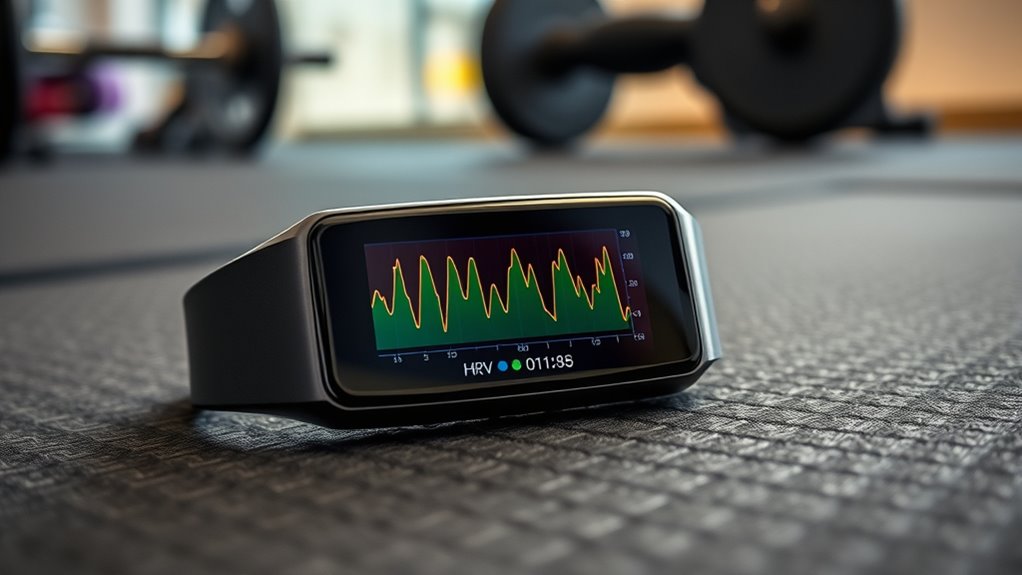
Heart rate variability (HRV) refers to the fluctuations in the time intervals between your heartbeats, and it offers valuable insight into your body’s overall stress and recovery status. When your HRV is high, it indicates that your autonomic nervous system is balanced, promoting better cardiac coherence and resilience. Conversely, low HRV suggests stress, fatigue, or overtraining, signaling your body needs rest. The autonomic nervous system, which controls involuntary functions, influences HRV by balancing sympathetic and parasympathetic activity. Understanding this link helps you recognize how well your body is adapting to training or stressors. By monitoring HRV, you can optimize your training, improve recovery, and maintain overall heart health, making HRV a vital tool for personalized fitness and well-being. Comfort and support solutions can also play a role in recovery by creating an environment conducive to rest and relaxation. Additionally, awareness of vital signs like HRV allows for more precise adjustments to training intensity and recovery strategies. Recognizing the importance of mental health in overall well-being can further enhance your recovery process.
How to Measure and Track Your HRV Data
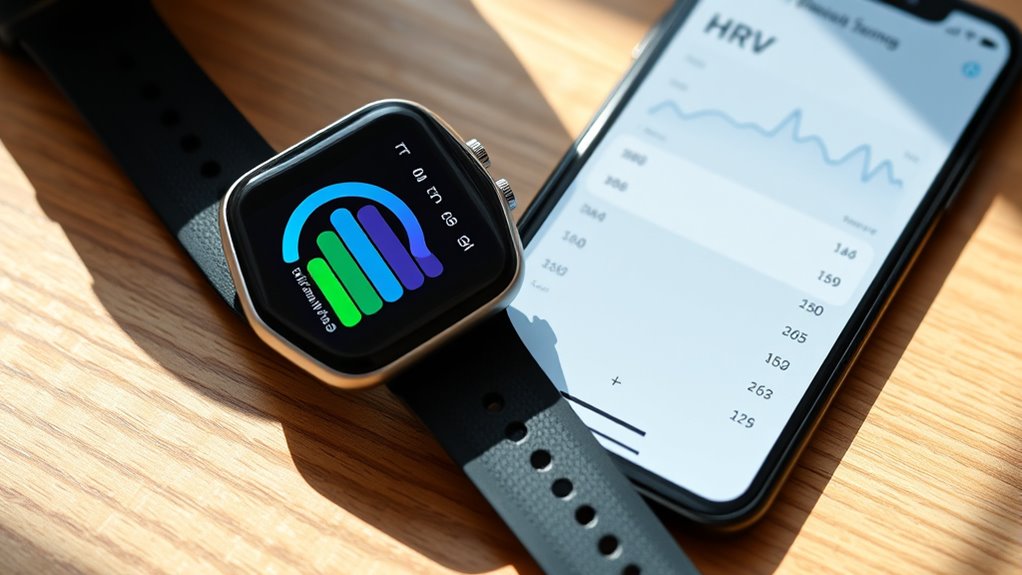
To effectively monitor your HRV, you’ll need to know how to measure and track your data accurately. Start by using a reliable heart rate monitor or HRV tracking app that syncs with your device. Measure your HRV at the same time each morning, ideally after waking up, to reduce variability. Pay attention to factors like sleep quality and hydration levels, as they influence your readings. Keep a consistent routine, avoiding alcohol or intense exercise beforehand, to ensure accuracy. Record your daily HRV scores along with notes on sleep and hydration. Tracking these consistently helps identify patterns over time, giving you a clear picture of your readiness and recovery status. Incorporating performance tuning principles can help optimize your overall wellness by ensuring your body operates efficiently. Using a high-quality home theatre projector can enhance your viewing experience, especially during recovery periods when relaxation is key. Additionally, understanding the contrast ratio of your devices can help you choose the best visual environment for recovery and focus. Accurate measurement is key to making informed training decisions based on your HRV data.
Establishing Your Baseline HRV Levels
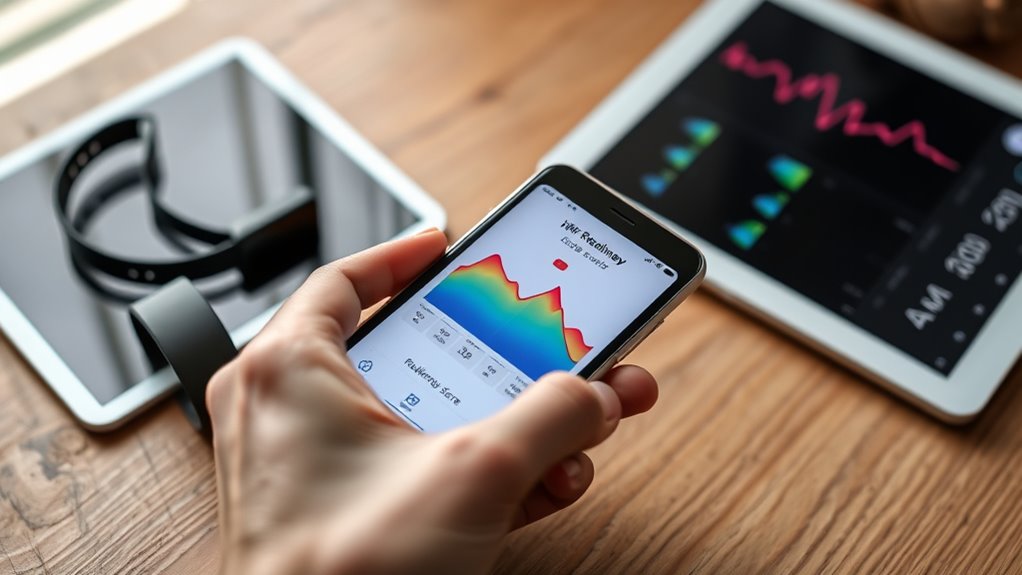
Before you can interpret your HRV data effectively, you need to establish your baseline levels. This is essential in HRV science to understand what’s normal for your body and optimize athlete recovery. To do this:
Establish your baseline HRV to understand your body’s norm and enhance recovery.
- Record your HRV measurements consistently, ideally at the same time each morning.
- Track your data over at least two weeks to identify patterns and variations.
- Note factors like sleep, stress, and activity that influence your HRV levels.
- Consider how AI discoveries could enhance your understanding of physiological data for personalized health insights. Recognizing the importance of father-daughter bonds can also serve as a reminder of the value of consistent and supportive relationships in achieving personal well-being.
Interpreting Readiness Scores and What They Indicate

Interpreting your readiness scores is key to optimizing your training and recovery efforts. A high score generally indicates you’re mentally resilient and well-rested, suggesting you’re prepared for intense workouts. Conversely, a low score may signal poor sleep quality or increased mental fatigue, highlighting the need for rest or lighter activity. Pay attention to patterns over time—consistent low scores can impact your mental resilience and hinder progress. Improving sleep quality can boost your readiness scores, supporting better recovery and resilience. Incorporating lifestyle habits like regular breaks and stress management can further enhance your scores and overall well-being. Developing cultural intelligence in your approach to training can also help you better understand and adapt your routines to optimize performance. Remember, these scores aren’t just numbers—they reflect how well your body and mind are prepared for training. Use them to make informed decisions, ensuring you balance effort with proper recovery for sustained progress and overall well-being.
Setting Personalized Training Goals Based on HRV

Setting personalized training goals based on your HRV involves using your readiness scores to tailor workouts that align with your current recovery and resilience levels. Your HRV reflects factors like sleep quality and nutritional impact, which influence your ability to perform. To optimize your training, consider that nutritional value of juices can affect your recovery and energy levels, making proper nutrition an essential component of your training plan. Additionally, understanding the role of sleep and mental health can help you better interpret your HRV readings and adjust your routines accordingly. Recognizing the patterns in angel numbers can also provide additional insight into your emotional state and readiness for change. 1. Adjust intensity: When your HRV indicates high readiness, push harder; if low, focus on recovery. 2. Prioritize recovery: Use low scores to emphasize rest, ensuring better sleep quality and nutritional support. 3. Set realistic targets: Align your goals with your physiological state, helping prevent overtraining and supporting overall resilience.
Adjusting Your Workout Intensity According to Readiness
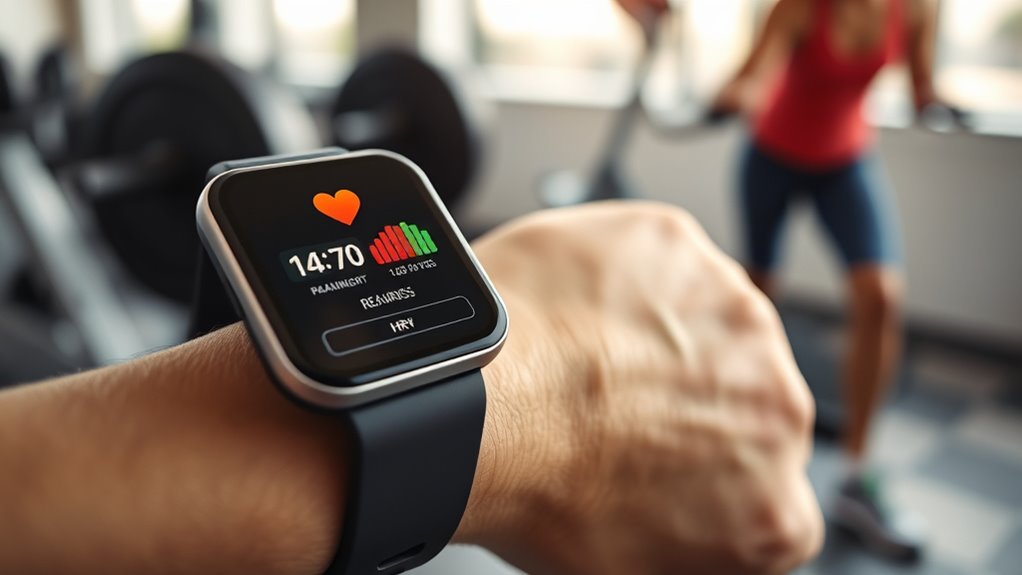
Your readiness score tells you how prepared you are for intense exercise today. By interpreting these scores, you can modify your workout intensity to match your current state. Tracking your progress helps guarantee you’re training effectively and avoiding overtraining. Incorporating proper warm-up techniques can further optimize your performance and reduce the risk of injury. Additionally, paying attention to relationship dynamics can help you better manage stress and maintain motivation during your training journey. Understanding performance tuning principles can also guide you in adjusting your training plans for optimal results and sustained progress.
Interpreting Readiness Scores
When your readiness score indicates you’re well-prepared, it’s a signal to push yourself harder during workouts. High scores often reflect favorable biological markers and positive recovery metrics, meaning your body is ready for increased intensity. To interpret these scores effectively:
- Look for consistent high scores over several days, indicating ideal recovery.
- Consider biological markers such as heart rate variability (HRV) and sleep quality for deeper insights.
- Use recovery metrics to confirm if your body is truly prepared, avoiding overtraining or injury.
- Keep in mind that AI safety measures are essential for improving the reliability of health-related AI tools.
A solid readiness score suggests your autonomic nervous system is balanced, and your recovery is on track. Trust these indicators to personalize your training, maximizing performance while minimizing fatigue and risk.
Adjusting Workout Intensity
Adjusting workout intensity based on your readiness scores guarantees you train safely and effectively. When your HRV indicates high readiness, you can push harder, enhancing recovery optimization and building strength. If your scores show stress or fatigue, dial back the intensity to prevent overtraining and support stress management. This tailored approach helps you avoid injury and burnout while maximizing performance gains. On days with lower readiness, opt for lighter workouts or active recovery to give your body time to restore energy and reduce stress. Additionally, paying attention to the accuracy of your HRV measurements can improve your training decisions. Recognizing the importance of healthy hydration habits, such as consuming no-sugar-added juices, can also support recovery and overall well-being. Incorporating structured tuning modifications can optimize your physical performance further, aligning with your body’s needs. By aligning your workout intensity with your physiological signals, you promote smarter training, better recovery, and sustained progress. Always listen to your body, adjusting effort levels accordingly to maintain a healthy balance between exertion and recovery.
Monitoring Your Progress
Monitoring your progress involves tracking how your body responds over time and making informed adjustments to your workout plan. Pay attention to changes in your readiness scores, which reflect your recovery and overall stress. To optimize your training:
- Prioritize sleep quality, as better sleep improves HRV and readiness scores, guiding you to increase or decrease workout intensity.
- Consider nutrition impact; proper fueling supports recovery and enhances your body’s response to training.
- Regularly review your readiness scores to identify patterns, adjusting workout intensity accordingly—if scores dip, opt for lighter sessions or rest.
Monitoring Progress and Re-calibrating Scores Over Time
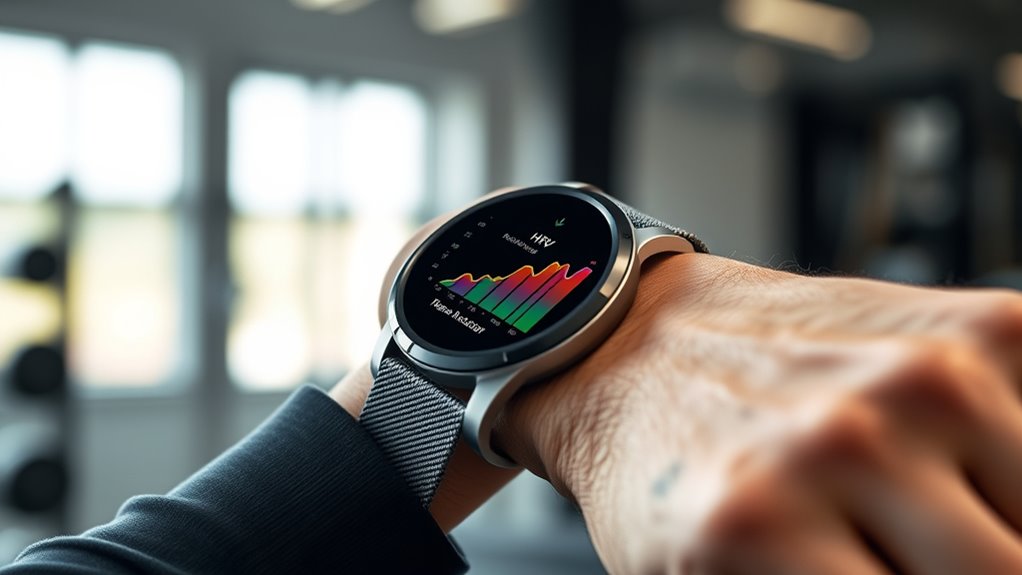
To monitor your progress effectively, you need to observe long-term HRV trends rather than just daily changes. As your fitness improves, your readiness scores may shift, requiring you to adjust your thresholds accordingly. Regularly re-calibrating these scores helps guarantee your training stays aligned with your current capacity. Incorporating wall organization systems into your home environment can also promote better mental clarity and focus during your training routines.
Tracking Long-term Trends
Tracking long-term trends in HRV-guided training allows you to see how your body responds over weeks and months, helping you identify patterns of improvement or signs of overtraining. To effectively monitor progress, focus on these key areas:
- Review your HRV data regularly to spot gradual increases or decreases, indicating your adaptation or potential fatigue.
- Incorporate mindfulness practices to reduce stress, which can positively influence your HRV and overall recovery.
- Prioritize sleep optimization since quality sleep considerably impacts HRV, helping you sustain consistent progress.
Adjusting Readiness Thresholds
As your training progresses, adjusting your readiness thresholds guarantees your HRV-guided approach remains accurate and effective. Over time, seasonal adjustments may be necessary, as environmental factors like temperature and daylight influence your HRV baseline. Additionally, psychological factors such as stress, sleep quality, or mood can impact your scores, requiring recalibration. Regularly review your data to identify shifts in your baseline and modify thresholds accordingly. If you notice persistent fluctuations unrelated to training intensity, consider adjusting your criteria to better reflect your current state. This ongoing recalibration ensures your readiness scores accurately represent your true condition, helping you avoid overtraining or undertraining. Staying attentive to these factors keeps your HRV-guided training personalized and responsive to your evolving needs.
Best Practices for Integrating HRV Data Into Daily Training

Integrating HRV data into your daily training requires a strategic approach to guarantee you make meaningful adjustments without overreacting to short-term fluctuations. First, monitor trends over time rather than reacting to daily changes. Second, consider sleep quality and nutrition impact, as poor sleep or nutrition can temporarily lower HRV, skewing your assessment. Third, establish clear thresholds aligned with your goals, adjusting only when HRV deviates consistently from baseline. Use HRV alongside subjective measures like fatigue and mood to get a complete picture. Remember, minor dips may signal recovery needs, not training cessation. By following these practices, you ensure your training remains adaptive, personalized, and effective, helping you optimize performance without unnecessary setbacks.
Frequently Asked Questions
Can HRV Readings Be Affected by Factors Other Than Training?
HRV readings can definitely be affected by factors beyond training, like stress impact and hydration effects. When you’re stressed or dehydrated, your HRV might drop, making you seem less ready than you actually are. These influences can skew your results, so it’s important to take into account your overall state. Monitoring your HRV alongside other signs can help you get a more accurate picture of your readiness and recovery.
How Often Should I Measure My HRV for Accurate Insights?
Did you know that measuring your HRV daily can improve data consistency and give you clearer insights? For accurate results, you should measure your HRV at the same time each morning, ideally daily. This frequency helps you track trends over time and avoids fluctuations caused by inconsistent timing. Consistent measurement allows you to better understand your body’s responses and adjust your training accordingly.
Are There Specific Times of Day Best for Taking HRV Measurements?
When considering measurement timing, it’s best to take your HRV readings at the same time every day for daily consistency. Early morning, right after waking up, is ideal because your body’s at rest and less affected by daily activities. This consistency helps you accurately track trends over time. Avoid measuring immediately after exercise, stress, or caffeine, as these factors can skew your results.
How Do Age and Gender Influence HRV and Readiness Scores?
You might notice that age-related variability impacts HRV and readiness scores, making younger individuals often show higher scores than older ones. Gender differences also play a role, with women typically exhibiting slightly higher HRV than men. While these factors influence baseline measurements, tracking your personal trends over time remains key. Embrace these natural variations, and focus on your individual progress rather than comparing yourself directly to others.
What Are Common Mistakes to Avoid When Interpreting HRV Data?
When interpreting HRV data, avoid misinterpretation pitfalls like ignoring individual variability and overgeneralizing results. Don’t rely on a single measurement; instead, track data consistency over time to identify true trends. Be cautious about external factors like stress or sleep that can skew readings. Remember, HRV is personal, so understanding your baseline helps prevent misjudging your readiness or recovery status.
Conclusion
By tracking your HRV and using readiness scores, you can personalize your training and prevent overtraining. Did you know that athletes who adjust workouts based on HRV see up to a 20% improvement in performance? Incorporating this data helps you train smarter, stay consistent, and optimize recovery. Keep monitoring your scores regularly, and you’ll release your full potential while reducing injury risk. Start using HRV-guided training today for better, more effective workouts.









